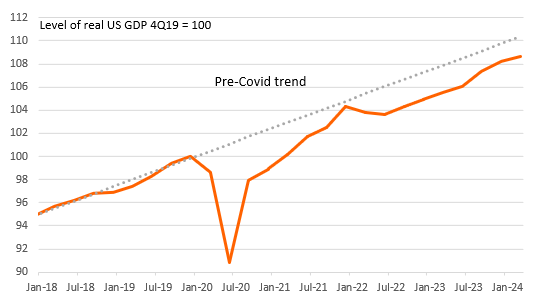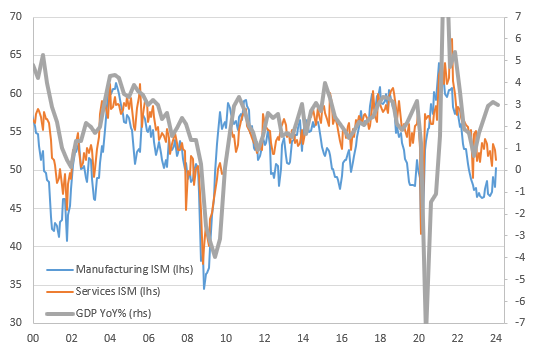US GDP Growth Slows Markedly, And Inflation Remains The Focus

Image Source: Pixabay
US GDP growth slowed to 1.6% annualized in the first quarter of this year, less than half the 3.4% rate recorded in 4Q23, but core inflation was stronger, picking up from a 2% annualized rate to 3.7%. This implies upside risks to tomorrow’s key monthly core PCE deflator and makes a near-term rate cut even less likely.
Higher inflation catches the markets' eye, rather than weaker growth
US first quarter GDP growth is an annualized 1.6%, well below the 2.5% consensus expectation, but inflation is hotter with the core PCE deflator up 3.7% annualized versus 3.4% expected. This suggests, assuming no revisions to monthly data, that the core PCE deflator will come in above 0.4% tomorrow rather than the current 0.3%MoM consensus forecast. Unsurprisingly, Treasury yields have pushed higher as if that is the case, it makes a near-term Federal Reserve interest rate cut look even more unlikely.
That said, this inflation number is a quarter-on-quarter annualized measure, so any revisions to October through February could have influenced today's outcome - we won't know until tomorrow when we get the monthly income and spending report. We could still get a 0.3%MoM, but we have to acknowledge that today’s data makes it look less likely.
GDP levels versus pre-pandemic trend

Source: Macrobond, ING
GDP still running below pre-pandemic trend levels
In terms of the GDP growth breakdown, consumer spending was softer than thought likely, rising 2.5% annualized, while residential investment was a very firm +13.9%. Business capex was subdued, government spending saw a marked slowdown to 1.2%, while weakness in net trade subtracted 0.9pp from the headline growth rate, and inventories subtracted a further 0.35pp. The chart above shows that while GDP has performed well, the level of output is still a couple of percentage points below where we perhaps could have been had the pandemic not happened, and instead, the economy had continued running at its 2024-19 growth trend.
Business surveys are painting a weaker picture than GDP growth

Source: Macrobond, ING
As for the growth outlook, we expect to see more subdued activity in upcoming quarters. The divergence between business surveys and official data is very wide. We strongly suspect that business caution will translate into weaker hiring and wage growth and subdued business capex, and that will eventually show up in the official GDP data. The move higher in market borrowing costs this year will also weigh on activity and eventually dampen price pressures in the economy. Nonetheless, there is next to no chance of a rate cut before September.
More By This Author:
Japanese FX Intervention: Primed And Ready
FX Daily: When The Second Decimal Place Counts
FX Daily: Survey Divergence Hits The Dollar
Disclaimer: This publication has been prepared by the Economic and Financial Analysis Division of ING Bank N.V. (“ING”) solely for information purposes without regard to any ...
more


